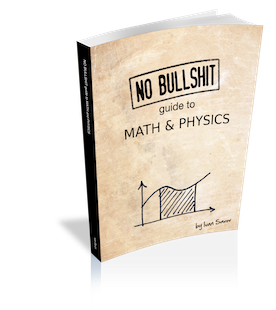The page you are reading is part of a draft (v2.0) of the "No bullshit guide to math and physics."
The text has since gone through many edits and is now available in print and electronic format. The current edition of the book is v4.0, which is a substantial improvement in terms of content and language (I hired a professional editor) from the draft version.
I'm leaving the old wiki content up for the time being, but I highly engourage you to check out the finished book. You can check out an extended preview here (PDF, 106 pages, 5MB).
Compound interest
Soon after ancient civilizations invented the notion of numbers, they started computing interest on loans.
Percentages
We often talk about ratios between quantities, instead of the quantities themselves. For example, we can imagine working Joe who invests $1000$ in the stock market and loses $300$, because the boys on Wall Street keep pulling dirty tricks on him. To put the number $300$ into perspective, we can say Joe lost about $0.3$ of his wealth or, alternately, $30\%$ of his wealth.
To obtain the percentage, you simply take the ratio between two quantities and then multiply by $100$. The ratio of loss to investment is: \[ R = 300/1000 = 0.3. \]
The same ratio expressed as a percentage gives \[ R = 300/1000 \times 100 = 30\%. \]
To convert from a percentage to a ratio, you simply have to divide by $100$.
Interest rates
Say you take out a $1000$ dollar loan with interest rate of $6\%$ compounded annually. How much money will you need to pay in interest at the end of the year?
Since $6\%$ corresponds to a ratio of $6/100$, and since you took out $1000$, the interest at the end of the year will be: \[ I_1 = \frac{6}{100}\times 1000 = 60. \]
At the end of the year, you owe the bank a total of \[ L_1 = \left(1 + \frac{6}{100}\right)1000 = (1 + 0.06) 1000 = 1.06\times 1000 = 1060. \]
The total money owed after 6 years is going to be: \[ L_6 = (1.06)^6 \times 1000 = 1418.52. \] Better pay up or else they will have your head soon! Or default maybe? Is your credit rating really that important?
Monthly compounding
The above scenario assumes that the bank computes the interest once per year. Such a compounding schedule is disadvantageous to the bank, and since they write the rules it is never used. Usually, the compounding is done every month.
What is the annual rate then? The bank will quote the nominal APR (annual percentage rate), which is equal to: \[ \text{nAPR} = 12 \times r, \] where $r$ is the monthly interest rate.
Suppose we have an nominal APR of $6\%$, which gives a monthly interest rate of $r=0.5\%$. If you take out a $1000$ loan at that interest rate, you will owe: \[ L_1 = \left(1 + \frac{0.5}{100}\right)^{12} \times 1000 = 1061.68, \] at the end of the first year, and after 6 years you will owe: \[ L_6 = \left(1 + \frac{0.5}{100}\right)^{72}\times 1000 = 1.061677^{6} \times 1000 = 1432.04. \]
Note how the bank tries to pull a fast one on you. The effective APR is actually $6.16\%$ not $6\%$! Indeed, each twelve months, the amount due will increase by the following factor: \[ \textrm{eAPR} = \left(1 + \frac{0.5}{100}\right)^{12} = 1.0616. \] Thus the effective annual percent rate is $\textrm{eAPR} = 6.16\%$.
Compounding infinitely often
For a nominal APR of $6\%$, what would be the effective APR if the bank was to do the compounding $n$ times per year?
The annual growth ratio is going to be: \[ \left(1 + \frac{6}{100n}\right)^{n}, \] since you have interest rate per compounding period is $\frac{6}{n}\%$ and there are $n$ periods in one year.
In the limit of compounding infinitely often, we will see the exponential function emerge: \[ \lim_{n \to \infty} \left(1 + \frac{6}{100n}\right)^{n} = \exp\!\!\left(\frac{6}{100}\right) = 1.0618365, \] or an $\text{eAPR} = 6.183\%$.
With infinitely frequent compounding, the interest after 6 years will be: \[ L_6 = \exp\!\!\left(\frac{6}{100}\right)^6 \times 1000 = \exp\!\!\left(\frac{36}{100}\right) \times 1000 = 1433.33. \]
As you can see, for the same APR of $6\%$, the faster the compounding schedule, the more money you owe at the end of six years. It is a good thing that banks don't know about the exponential function then!
Links
Very good article and notation:
http://plus.maths.org/content/have-we-caught-your-interest
